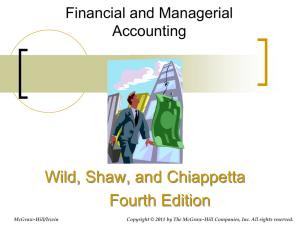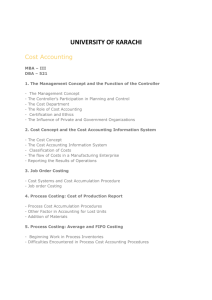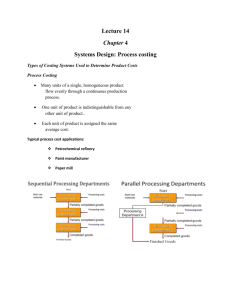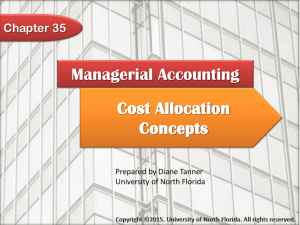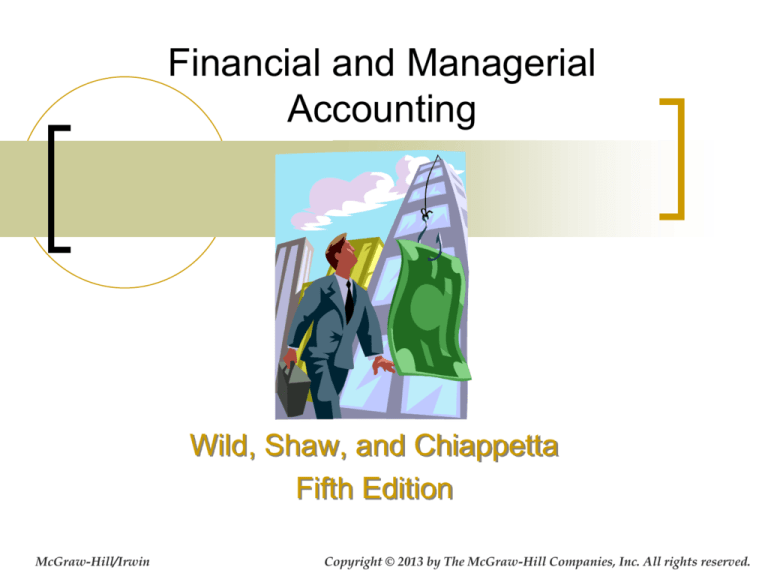
Financial and Managerial
Accounting
Wild, Shaw, and Chiappetta
Fifth Edition
McGraw-Hill/Irwin
Copyright © 2013 by The McGraw-Hill Companies, Inc. All rights reserved.
Chapter 16
Process Costing and Analysis
Conceptual Learning
Objectives
C1: Explain process operations and the way
they differ from job order operations.
C2: Define and compute equivalent units and
explain their use in process cost
accounting.
C3: Describe accounting for production activity
and preparation of a process cost
summary using weighted average.
C4: Appendix: 16A Describe accounting for
production activity and preparation of a
process cost summary using FIFO.
16-3
Analytical Learning Objectives
A1: Compare process cost accounting
and job order cost accounting.
A2: Explain and illustrate a hybrid costing
system.
16-4
Procedural Learning
Objectives
P1: Record the flow of direct materials costs in
process cost accounting.
P2: Record the flow of direct labor costs in
process cost accounting.
P3: Record the flow of factory overhead costs
in process cost accounting.
P4: Record the transfer of completed goods to
Finished Goods Inventory and Cost of
Goods Sold.
16-5
C1
Process Manufacturing
Operations
Used for production of
identical, low-cost items.
Mass produced in automated
continuous production process.
Costs cannot be directly traced
to each unit of product.
16-6
A1
Comparing Job Order and
Process Operations
Job Order Operations
Custom orders
Heterogeneous
products
Low production volume
Process Operations
Repetitive operations
Homogeneous products
High production volume
High product flexibility
Low product flexibility
Low to medium
standardization
High standardization
16-7
A1
Job and Process Costing
Similarities
Same objective: to determine
the cost of products
Same inventory accounts: Raw Materials,
Work in Process, and Finished Goods
Same overhead assignment method:
predetermined rate times actual activity
16-8
A1
Job and Process Costing
Similarities and Differences
Journal entries for
both job order and
process costing
are identical.
The difference
between job
order and
process costing
lies in how the
cost of goods
transferred to
finished goods
is determined.
16-9
A1
Job Order and Process
Costing Differences
Job order costing
Process costing
The cost of goods
transferred to
finished goods is
equal to the sum of
all of the completed
jobs for that period
The cost of goods
transferred to finished
goods equals the
number of completed
units times the cost
per equivalent unit
16-10
P1
Process Costing
Typical Accounting Entries
GENERAL JOURNAL
Date
Description
Raw Materials Inventory
Accounts Payable
Page 21
Post.
Ref.
Debit
Credit
XXXXX
XXXXX
Acquired materials on credit for
use in the factory.
16-11
P1
Process Costing
Typical Accounting Entries
GENERAL JOURNAL
Date
Description
Goods in Process Inventory
Raw Materials Inventory
Page 21
Post.
Ref.
Debit
Credit
XXXXX
XXXXX
To assign costs of direct material
used in production.
16-12
P1
Process Costing
Typical Accounting Entries
GENERAL JOURNAL
Date
Description
Factory Overhead
Raw Materials Inventory
Page 21
Post.
Ref.
Debit
Credit
XXXXX
XXXXX
To record indirect materials used
in April.
16-13
P2
Process Costing
Typical Accounting Entries
GENERAL JOURNAL
Date
Description
Factory Payroll
Cash
Page 21
Post.
Ref.
Debit
Credit
XXXXX
XXXXX
To record factory wages for April.
16-14
P2
Process Costing
Typical Accounting Entries
GENERAL JOURNAL
Date
Description
Goods in Process Inventory
Factory Payroll
Page 21
Post.
Ref.
Debit
Credit
XXXXX
XXXXX
To assign costs of direct labor
used in production.
16-15
P3
Process Costing
Typical Accounting Entries
GENERAL JOURNAL
Date
Description
Factory Overhead
Factory Payroll
Page 21
Post.
Ref.
Debit
Credit
XXXXX
XXXXX
To record indirect labor as
overhead.
16-16
P3
Process Costing
Typical Accounting Entries
GENERAL JOURNAL
Date
Description
Factory Overhead
Page 21
Post.
Ref.
Debit
Credit
XXXXX
Prepaid Insurance
XXXXX
Utilities Payable
XXXXX
Cash
XXXXX
Accumulated Depreciation
XXXXX
To record factory overhead items
incurred during April.
16-17
P3
Process Costing
Typical Accounting Entries
GENERAL JOURNAL
Date
Description
Goods in Process Inventory
Factory Overhead
Page 21
Post.
Ref.
Debit
Credit
XXXXX
XXXXX
Allocated factory overhead costs to
production on the basis of direct
labor cost.
16-18
C2
Equivalent Units of Production
Equivalent units is a concept expressing a
number of partially completed units as a
smaller number of fully completed units.
Two one-half full pitchers are
equivalent to one full pitcher.
+
=
16-19
C2
Equivalent Units
40% of
material
60% of
material
Stage 1
Stage 2
Stage 3
25% of
labor and
overhead
25% of
labor and
overhead
50% of
labor and
overhead
The process is now complete.
16-20
C2
Cost per Equivalent Unit
Average
cost per
equivalent
unit
Product costs for the period
=
Equivalent units for the period
16-21
Process Manufacturing
Operations GenX
C1
Indirect
Materials
Direct
Factory
Allocated
Overhead
Indirect
Overhead
Labor
Direct
Goods in
Process
Finished
Goods
Delivered
to
Customers
16-22
C2
Accounting for GenX
GenX Production Data for April
Beginning inventory:
Units of product
Percentage of completion - direct materials
Percentage of completion - direct labor
Units started in April
Units completed and transferred out
30,000
100%
65%
90,000
100,000
Ending inventory:
Units of product
Percentage of completion - direct materials
Percentage of completion - direct labor
20,000
100%
25%
16-23
C2
Accounting for GenX
16-24
C2
Accounting for GenX
GenX uses a weighted-average cost flow
system with the following steps:
Determine the physical flow of units.
Compute equivalent units of production.
Compute the cost per equivalent unit.
Assign and reconcile costs.
16-25
C2
Determine Physical Flow of
Units
Exh.
20-13
GenX Physical Flow for April
Units to account for:
Beginning inventory
Units started during April
Total number of units
Units accounted for as:
Units completed and transferred out
Ending inventory
Total number of units
30,000
90,000
120,000
100,000
20,000
120,000
16-26
C2
Compute Equivalent
Units of Production - Materials
GenX
Direct Materials Equivalent Units of Production for April
Units of
Product
Percentage Equivalent
of Completion
Units
Equivalent units completed and
transferred out
100,000
100%
100,000
Ending goods in process
Total units
20,000
120,000
100%
20,000
120,000
16-27
C2
Compute Equivalent
Units of Production – Direct
Labor and Factory Overhead
GenX Direct Labor and Factory
Overhead Equivalent Units of Production for April
Units of
Product
Percentage Equivalent
of Completion
Units
Equivalent units completed and
transferred out
100,000
100%
100,000
Ending goods in process
Total units
20,000
120,000
25%
5,000
105,000
16-28
C2
Compute Equivalent
Units of Production
Equivalent Units of Production for April
Direct
Materials
Equivalent units completed and
tramsferred out
Equivalent units for ending
ending good in process
Equivalent units of production
for period
Direct
Labor
Factory
Overhead
100,000
100,000
100,000
20,000
5,000
5,000
120,000
105,000
105,000
16-29
C2
Compute Cost Per Equivalent
Unit
GenX
Cost Per Equivalent Unit for April
Direct
Materials
Costs of beginning goods
in process inventory
Costs incurred this period
Total costs
÷ Equivalent units of
production
Cost per equivalent unit
of production
$
3,300
9,900
$ 13,200
÷
= $
120,000 ÷
Direct
Labor
$
Factory
Overhead
600
5,700
$
720
6,840
$ 6,300
$
7,560
105,000 ÷
0.11 = $
0.06 = $
105,000
0.072
16-30
C2
Cost Reconciliation
In the cost reconciliation, we will
account for all costs incurred
by assigning unit costs to the:
A. 100,000 units transferred out.
B. 20,000 units remaining in ending
inventory.
16-31
C2
No. of EU of
direct labor
16-32
C3
Process Cost Summary
Shows the flow
of units and costs
through work in
process.
Provides cost
information for
financial
statements.
Process
Cost
Summary
Helps factory
managers evaluate
department manager
performance.
Helps managers
control their
departments.
16-33
C3
Process Cost Summary
(part 1)
16-34
C3
(part 2)
16-35
C3
(part 3)
16-36
C3
(part 3 continued)
16-37
P4
Process Costing
Typical Accounting Entries
GENERAL JOURNAL
Date
Description
Finished Goods Inventory
Goods in Process Inventory
Page 21
Post.
Ref.
Debit
Credit
XXXXX
XXXXX
To record the transfer of completed
goods out of production.
16-38
P4
Process Costing
Typical Accounting Entries
GENERAL JOURNAL
Date
Description
Cost of Goods Sold
Finished Goods Inventory
Page 21
Post.
Ref.
Debit
Credit
XXXXX
XXXXX
To record cost of goods sold
during April.
16-39
A2
Hybrid Costing Systems
Hybrid costing systems contain features
of both job order and process operations.
Job Order
Costing
Hybrid Costing
Material costs are
accounted for using
a job order system.
Process
Costing
Conversion costs are
accounted for using
a process system.
16-40
End of Chapter 16
16-41

